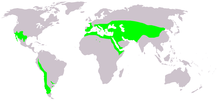Ephedraceae
| Ephedra | |
|---|---|
 |
|
| Ephedra fragilis in Mallorca | |
| Scientific classification | |
| Kingdom: | Plantae |
| Division: | Gnetophyta |
| Class: | Gnetopsida |
| Order: |
Ephedrales Dumort. |
| Family: |
Ephedraceae Dumort. |
| Genus: |
Ephedra L. |
 |
|
| Global range of Ephedra | |
| Synonyms | |
|
Chaetocladus J.Nelson |
|
Chaetocladus J.Nelson
Ephedra is a genus of gymnosperm shrubs, the only genus in its family, Ephedraceae, and order, Ephedrales. The various species of Ephedra are widespread in many lands, native to southwestern North America, southern Europe, northern Africa, and southwest and central Asia, northern China, and western South America.
In temperate climates, most Ephedra species grow on shores or in sandy soils with direct sun exposure. Common names in English include joint-pine, jointfir, Mormon-tea or Brigham tea. The Chinese name for Ephedra species is mahuang (simplified Chinese: 麻黄; traditional Chinese: 麻黃; pinyin: máhuáng; Wade–Giles: ma-huang; literally: "cannabis yellow"). Ephedra is also sometimes called sea grape (from the French raisin de mer), a common name for the flowering plant Coccoloba uvifera.
Plants of the genus Ephedra, including E. sinica and others, have traditionally been used by indigenous people for a variety of medicinal purposes, including treatment of asthma, hay fever, and the common cold. The alkaloids ephedrine and pseudoephedrine are active constituents of E. sinica and other members of the genus. These compounds are sympathomimetics with stimulant and decongestant qualities and are chemically substituted amphetamines.
...
Wikipedia
